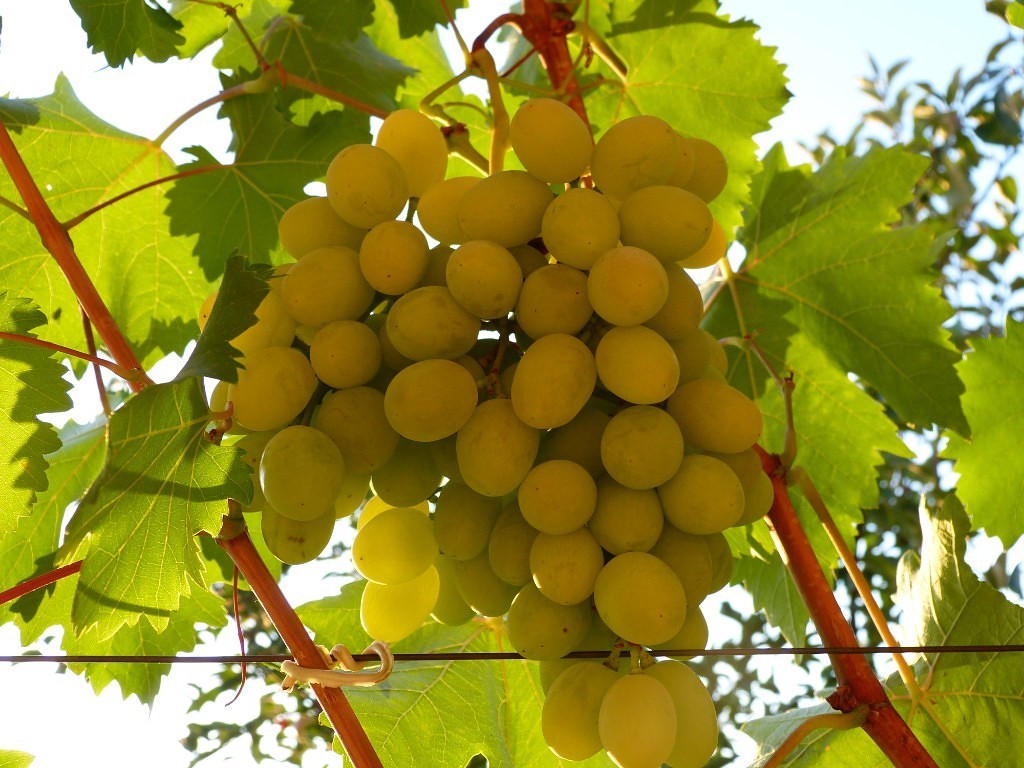
Lancelot is a favorite of winegrowers, it is characterized as a reliable hybrid, stably giving excellent harvests. The variety is successfully cultivated in many countries in summer cottages and in large industrial lands. There are practically no drawbacks, but there are no advantages, even the decorative nature of the bush deserves attention. Grapes Lancelot will not leave anyone indifferent.
Content
Origin history
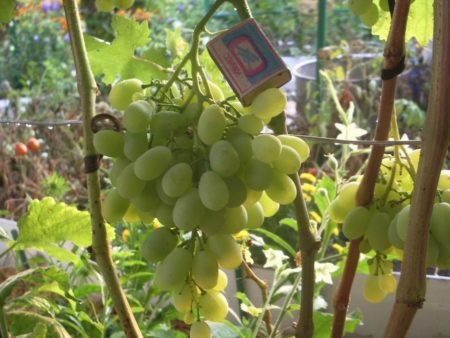
Lancelot white grapes were bred about 15 years ago by scientists at the Potapenko Ya. I. VNIIV in the city of Novocherkassk. The hybrid of the Ecstasy and FV-3-1 varieties was taken as a basis, as well as the Gift Zaporozhye. The main idea was to create a frost-resistant variety, and a host of other positive qualities, which in the process of selection received a hybrid became a pleasant gift for its authors. Lancelot was introduced to Russia in 2010.
At the same time with Lancelot at the Institute, such varietieslike Ivanhoe, Arthur, Merlin. They were planned as similar forms, but after a while it turned out that there was no difference between them, all 4 varieties are twins. How it happened is a mystery, but only Lancelot gained wide popularity.
Characteristics of Lancelot grape
A hybrid of medium-early maturity, from the appearance of the kidneys to the cut, 125-130 days pass. A bush without shelter withstands frosts up to 24 degrees, some gardeners say that with good snow cover, Lancelot withstood a short-term temperature drop of up to 27 degrees.
Resistance to diseases is good, however, in some years, partial damage by oidium is observed. Of the pests, sparrows are a danger, and wasp berries with a dense skin are of little interest to wasps. Late spring frosts can also harm Lancelot, the frosted vine is poorly restored.
Description of the bush, clusters and berries
The bush is powerful, tall, develops quite quickly, the vine is flexible, brick color. The leaves are medium, slightly dissected, dark green. Shoot ripening is excellent. The flowers are bisexual, the hybrid bears fruit well without pollinating varieties. The cluster is conical or broad-conical, large and dense from 800 grams to 1, 2 kilograms, in rare cases, the brush can weigh up to 3 kilograms.
The berries are large (37x26 mm), oval with a blunt tip, about 12-15 grams, light golden-green or white-golden, amber due to a light waxy coating have a milky hue. The skin is medium thick, strong, the pulp is dense, crisp, juicy and fleshy, with few seeds. Irrigation is not observed even with heavy loading of the bush with berries.
The taste is pleasant honey-citrus (without nutmeg aroma), sugar content of about 19%, and the acid level in a liter of juice does not exceed 7 grams. Berries practically do not crack when overripe or when waterlogged, single burst specimens quickly rot. A blush forms on the skin in the sun, which slightly spoils the presentation of the brushes.
Yield Indicators, Use
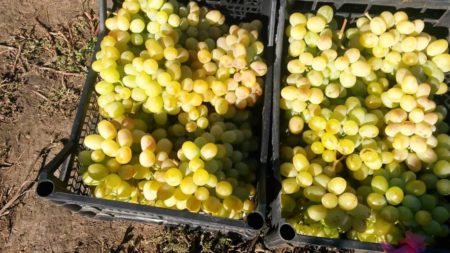
The bush begins to bear fruit in the third year, the yield is very high, the vine ripens almost the entire length.In order not to overload the plant, it is necessary to prune for 6-8 eyes, the norm will be 35 eyes per bush. When cutting off excess inflorescences, the berries ripen a little earlier than the originally declared deadline. An adult bush is capable of pulling a load of up to 50 kilograms or more. The amount of harvest depends on many factors (age of the vineyard, growing region, weather conditions and pruning).
The brushes do not lose their appearance during transportation, only the ripened berries are showered, the product characteristics of Lancelot are very high, it is often are grown for sale. The clusters are well stored in a cool place for up to 2, 5 months, do not lose their appearance and taste. Appointment table.
Advantages and disadvantages
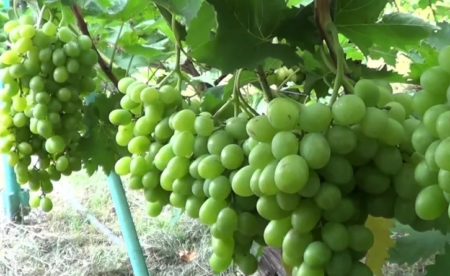
The hybrid has very few disadvantages, and we will begin with them. The first thing noted by wine growers growing Lancelot for sale is the negative impact of the sun on the appearance of berries. However, an unsightly blush rarely affects the choice of buyers, in general, clusters remain very attractive. With severe burns, the berries deteriorate, dry and rot. Another drawback is the lack of resistance of the vine to spring return frosts, all damaged branches are immediately cut off. Let's move on to the positive sides of Lancelot:
- good taste and appearance of berries;
- no need to select pollinators;
- resistance to diseases and most harmful insects;
- frost resistance, the ability to grow a hybrid in regions with a cool climate;
- simplicity in care;
- great growth power, excellent ripening of the vine;
- productivity;
- a small number of small berries;
- keeping up and transportability.
Let's go back to the minuses, we note one more point - most often the first 2 eyes are infertile, this should be taken into account when trimming, leave at least 3, and preferably 4, kidneys. In general, the hybrid is very good, which is noted by numerous positive reviews, with growing grape Even inexperienced gardeners can handle Lancelot.
Growing Features
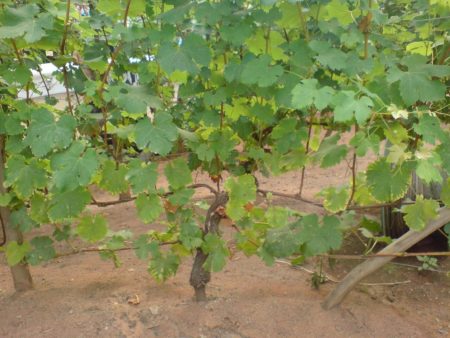
Seedlings should be strong, from 50 cm in length with a developed, healthy root system. In preparation for planting, the stem is shortened to 3-4 eyes, and the root to 10-15 cm. The place chosen is open, well warmed by the sun, windless with permeable, fertile soil. It is advisable to let the vine on the trellis.
Grape planting Lancelot can be carried out in the spring, when the risk of return frosts passes and in the fall from the second half of September until the onset of severe frosts. The plant tolerates significant cooling, but not in the early stages of development. In the first year, grapes are covered with bulk containers, completely covered with soil or sand.
How to care for Lancelot grapes
Grape Care Lancelot is standard. As a cover culture, it is grown only in regions where the temperature in winter drops below 25 degrees, while there is practically no snow. The branches of an adult vineyard are bent as much as possible to the earth, wrapped up or covered with polyethylene (on arcs).
Watering
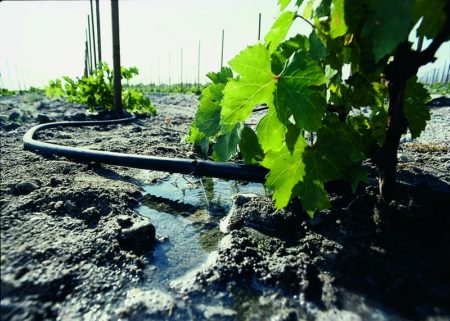
The first watering is carried out when planting (3 buckets under the bush), then before flowering and immediately after, the amount of water is the same - 15 liters.Humidification may be required in drought, the last watering is necessary before wintering, before leaf fall, when the entire crop is harvested. 100 l of water is poured onto one square meter of land, the procedure is carried out in several stages, so that moisture is gradually absorbed into the soil.
In the spring and 2-3 times over the entire growing season, the bushes are mulched with straw, ash, tops of garden plants, dry leaves or peat. Mulch prevents the growth of weeds, delays the evaporation of moisture, creates a greenhouse effect in the heat, while the soil does not compact, breathes.
Top dressing
Prior to fruiting, additional fertilizers are not needed, after every 2 or 3 years they spend spring bush feeding organic or minerals, as well as nitrogenous fertilizers (50 grams per square meter). After flowering, phosphorus-potassium mixtures or compost and humus should be added. About 6 kilograms of organic matter (per square meter) is made under an adult bush, and half less under a young bush.
Pruning
For a hybrid, a long or medium pruning is recommended, no more than 6 or 8 buds should be left on each branch, it is noted that the first 2 do not give strong shoots, and 3 and 4 can develop poorly. The main pruning is carried out in the fall after leaf fall, in the spring remove excess and frost-bitten branches. On one bush, it is desirable to leave from 3 to 8 sleeves.
Disease and Pest Prevention
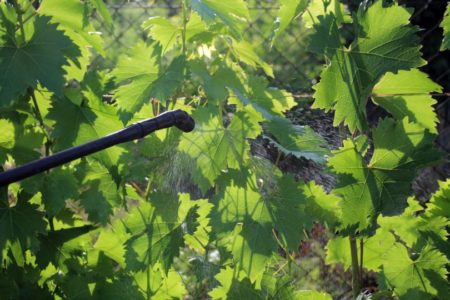
You can protect berries from wasps with special bags that will partially save them from sunburn. From sparrows install various noisy appliances. Lancelot's resistance to disease is above average, however, winegrowers recommend annual protective treatment of the bushes before and after flowering, as well as when the berries are the size of a pea. Use 1% Bordeaux liquid, Fundazole, Strobi, Quadris and other fungicides. Means need to be alternated. After harvesting, the bushes are sprayed with iron sulfate (a kilogram of funds per 5 liters of warm water).
Lancelot grapes were bred relatively recently, tests are still ongoing. Therefore, a more objective and reliable assessment of the hybrid can be obtained later. But now the variety is showing its worthy side in many countries and regions, it is actively bred on industrial vineyards, and a high commodity value of berries is noted.
Reviews
Andrei
Lancelot is my first white grape. Very pleased with him, tan on the berries of nonsense, given the frost resistance, good development of the bush and ease of care. The taste of berries cannot be called bright and saturated, it is neutral, but incredibly pleasant. The brushes are stored very well, I spread them in wooden boxes lined with parchment in one layer, put the cellar, we eat grapes almost until the beginning of December, the taste is not lost.
Antonina
I have tried many grape varieties that are suitable for central Russia; I have Lancelot among the best. It is not necessary to cover, the care is standard, when overripe, most of the berries remain in the hands, they do not crack in wet weather, do not rot - a find! I carry out the treatments as usual - 2 in the spring, summer and autumn, I try to use biological products Mikosan-B, Alirin-B, Gamair or Fitosporin-M.




 Non-covering winter-hardy grape varieties for Moscow region
Non-covering winter-hardy grape varieties for Moscow region How to keep the vine in winter
How to keep the vine in winter When can I transfer grapes to another place in the fall
When can I transfer grapes to another place in the fall How to cover and prepare grapes for the winter in the suburbs
How to cover and prepare grapes for the winter in the suburbs
Alexander Ivanovich Yushchenko
Dear author of the article, you absolutely do not know geography. The city of Novocherkask is not Ukraine, but Russia, Rostov Region, and therefore it did not have to be imported to Russia. The site is not bad but offensive errors from not owning a question. Before publishing the material, ask to check the material of the specialists of Vinogradare